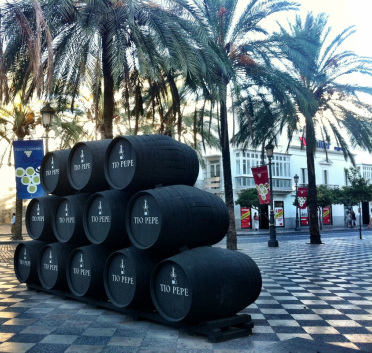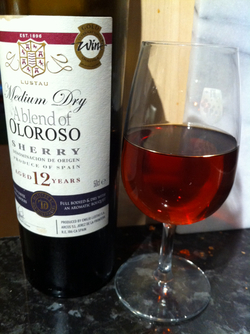 A display of barrels in the streets of Jerez, where sherry originates
A display of barrels in the streets of Jerez, where sherry originates Reasons to give Sherry a try:
1) These wines love food: from olives to ice cream
2) There are a range of styles to suit different palates
3) Amazing complexity of wine for reasonable prices
4) Newly fashionable with the rise of upmarket tapas
5) Single malt whisky fans may already be a fan of the flavours of sherry, since many are aged in sherry casks
One note of caution: unless you're in a central London Tapas bar like Fino, José or Barrafina, I wouldn't recommend trying sherry by the glass in many bars. The best way to serve these wines is young, cold and fresh, not at room temperature from a bottle that's been open for 2 weeks. You wouldn't serve your £4.99 bottle of Pinot Grigio that way, and these wines require at least the same respect.
I've sampled a few of the award-winning examples available at high street supermarket, Sainsbury's to help you find the sherry style that suits you best.
Manzanilla - for fans of green olives
 La Gitana Manzanilla 15% abv (£6 Sainsbury's 50cl)
La Gitana Manzanilla 15% abv (£6 Sainsbury's 50cl) The "La Gitana" Manzanilla, a Gold Medal winner in the International Wine Challenge (IWC), is made by a family-owned Bodega, Hidalgo. It's one of Spain's oldest wine brands dating back to 1792, and they've been aging their wines in American oak casks in the same cellar (bodega), closest to the sea, since that time.
With all this iconic history, you can expect a traditional Manzanilla style, and as the Gold Medal implies, this is an archetypal example of these delicate "flor aged" wines. Hidalgo are also unusual in that they take care of growing most of their own grapes too, allowing them to control the process from start to finish. (Some producers buy in co-operatively grown grapes rather than growing their own, and focus purely on the wine-making side.)
La Gitana is widely available in supermarkets. You'll find it now at £10 for 75ml at Tesco and Waitrose, and in a handier "trial size" 50cl bottle at Sainsbury's for £8, at the time of writing (and drinking) this was on special offer at a truly tempting £6. There's never been a better time to try it. The IWC tasting note describes it as: "Beautifully delicate and a nutty, saline nose. The palate shows almonds, olives, lemon and apple. Complex and a long, salty, classy finish." I believe I was actually on the panel that awarded the gold medal.
This wine is designed to be drunk as soon as possible after bottling. All the aging it needs is done in the Bodega so your only task is to get it home, chill it thoroughly, and enjoy drinking it promptly. That's why I like the 50cl bottles. An aperitif for 2 over 2 nights and hey presto, it's gone.
Manzanilla is a perfect aperitif style of wine, and I usually enjoy it in place of the G&T my friends so often choose. It is salty, tangy and full ofumami, that mysterious savoury 5th flavour which just makes everything a little bit more delicious. La Gitana sings with this, and makes a perfect partner for olives, salted Marcona almonds, or even just a few crisps as an aperitif. I paired La Gitana successfully with a crab salad. The seaside taste of the wine complemented perfectly the seaside taste of the crab. It works really well with hams, chorizo and other cured meats, as well as vegetables such as spinach or tomatoes, since these are all high in umami flavours too.
If you like this wine, you may move on to slightly less delicate style Finos which, to me, have a more pronounced biscuity and yeasty flavour.
 An example of a Solera System and display of Flor Yeast aging at the Sandeman Bodega in Jerez (photo credit: Heather Harrison)
An example of a Solera System and display of Flor Yeast aging at the Sandeman Bodega in Jerez (photo credit: Heather Harrison) Oloroso - for lovers of Medjool Dates

Oloroso is Spanish for scented, fragrant, or smelly, depending who you ask. The IWC gold medal winning Sainsbury's Finest wine is quite pungent on the nose and has a really long finish - the tiniest sip can be tasted at least a minute later. That's one sign of a great quality wine, as are the many layers of complexity in this 12 year aged version.
Made by Lustau, their Manuel Lozano was announced yesterday as winner of the International Wine Challenge Fortified Winemaker of the Year, an honour he's now received a remarkable 8 times for his blending skill.
This wine has some seriously top credentials. It also won a further award as "Great Fortified Under £10".
The IWC tasting note says, "Pale mahogany. Molasses, chocolate, explodes on palate. Layers of orange peel, curry and nuts. Excellent length. Superb fresh lemon zest notes".
Curry in a wine flavour? I'm not so sure, but I do recommend trying it. It's juicy & mouthwatering & for the unprepared may be a little surprising. While it's fairly dry in terms of sugar content, the flavours are on the sweet end. I love the toffee tones, and there's something like medjool dates and hazelnuts, maybe even a hint of fresh fig.
At 20% abv it's definitely a wine for sipping not slurping, and it is pleasant an aperitif with some salted crisps, broad beans or nuts but it's equally appealing as an after dinner drink.
True Oloroso is essentially a dry wine with only up to 5 grams per litre of residual sugar (less than most Brut Champagne). However, because of the flavour profile with many "sweet" flavours, it can be misleading on the palate.
The wine I'm recommending was IWC gold medal winning Sainsbury's finest medium dry "blend of" Oloroso. (£8 for 50cl). This means it's a bit sweeter than a true Oloroso and has had some Pedro Ximenez (PX see below) added to make it into a sweeter style. Not enough PX is added to make it sweet enough to become a "Cream" style, which has between 115-140 grams of sugar per litre, much closer to the liqueur and dessert wine end of the spectrum. (Medium can have anything between 5 and 115 grams of sugar per litre. I was unable to find out the exact sweetness level of this example, but my guess is it's around the "dry" end at maybe 50g/l).
I can be hard to believe that Oloroso starts out from the same base wine as a Manzanilla or Fino. The difference is the Flor yeast aging is suppressed by extra fortification and oxiditive aging takes place in the same type of Solera System.
If you're not sure what that is, the Solera allows fractional blending over anything from 3 up to many years. This helps provide a more uniform product over time, while also adding deep layers of flavour. In Finos and Manzanillas the wines are shielded from oxygen by a layer of "flor" yeast, while in Oloroso, the wine is exposed to oxygen wihtin the barrel, hence it starts to become a much browner colour.
You really have to taste it to understand, and this one is definitely worth a try if you like the sound of it.
Whisky drinkers can now find Oloroso cask aged malts, so if you like those, chances are, you'll enjoy this.
Sherry Tips
Pedro Ximénez - for lovers of raisins

The Sainsbury's Taste the Difference Pedro Ximénez (12 year aged) is a very sweet treat. With a Gold medal from the International Wine and Spirits Challenge 2011, I agree, this is world class. I've tasted this type of wine many times. Some are just about good enough to pour on ice cream but at £8 for 50ml, this is a great value wine that's made to be sipped and enjoyed.
Sweet enough to pair with chocolate - it was a perfect match for a Gü "After Dark Salted Caramel & Chocolate" dessert & worked reasonably well with a less decadent Toblerone triangle on another occasion. How's that for a real world food match?
The acidity is what makes this wine different from lesser examples. It's really mouthwatering & in a sticky wine that's vital to stop it becoming cloying & overblown. The bottle indicates serving at room temperature, though I much prefer it chilled. Again, this stops it tasting just a tad too treacly. It will also help preserve the open wine if you keep it in the fridge, not that most of my chocaholic friends could hold on to this for more than a day or two.
Rich like liquid Christmas cake, there's raisin, prune, baked fig, and nutty goodness, some dark caramel & praline flavours, along with a dark molasses, black treacle toffee almost savoury, sweetness.
Sun-drying the Pedro Ximénez grapes concentrates the sugars (think of how sweet and dense sun-dried tomatoes are). They are then pressed into the base wine which spends 12 years in Solera system before being turned into this delight. The PX grape is white, just like the Palomino Fino grape, and can make a still white wine (M&S stock one, though I haven't yet tried it). It's the sun-drying and aging that turns this into a drink that looks a lot like liquid treacle, and almost as full-bodied.
Simply stunning. If you've got a sweet tooth, you must try this!
I do hope some of you will now be tempted to try at least one style of sherry, especially if you've always avoided it. Do share your results on our Facebook page.
Cheers!





 RSS Feed
RSS Feed
